人教版九年级英语Unit11说课稿.doc
- 格式:doc
- 大小:55.00 KB
- 文档页数:6
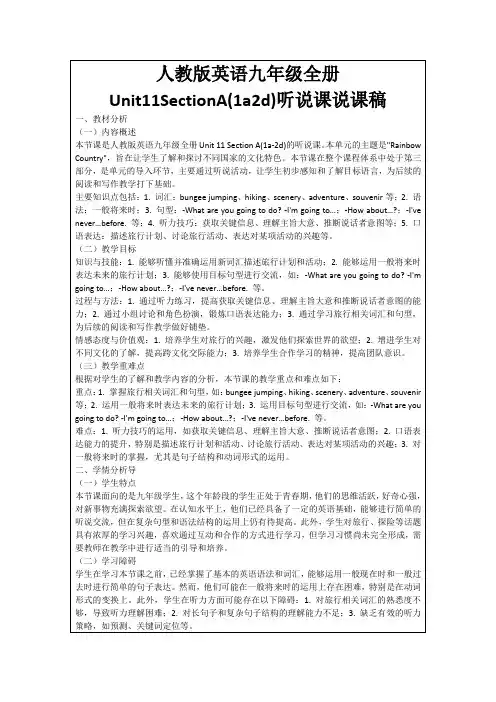
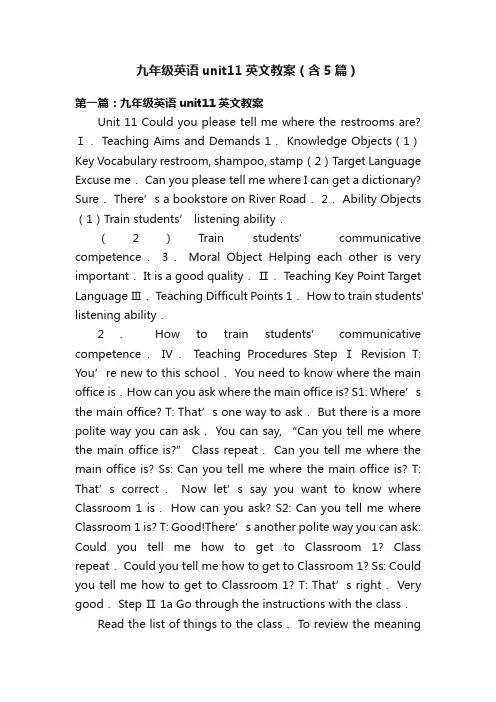
九年级英语unit11英文教案(含5篇)第一篇:九年级英语unit11英文教案Unit 11 Could you please tell me where the restrooms are? Ⅰ. Teaching Aims and Demands 1. Knowledge Objects(1)Key Vocabulary restroom, shampoo, stamp(2)Target Language Excuse me. Can you please tell me where I can get a dictionary? Sure.There’s a bookstore on River Road. 2. Ability Objects (1)Train students’ listening ability.(2)Train students’ communicative competence.3.Moral Object Helping each other is very important. It is a good quality.Ⅱ. Teaching Key Point Target Language Ⅲ. Teaching Difficult Points 1.How to train students’ listening ability.2.How to train students’ communicative competence.Ⅳ.Teaching Procedures Step Ⅰ Revision T: You’re new to this school. You need to know where the main office is.How can you ask where the main office is? S1: Where’s the main office? T: That’s one way to ask. But there is a more polite way you can ask.You can say, “Can you tell me where the main o ffice is?” Class repeat. Can you tell me where the main office is? Ss: Can you tell me where the main office is? T: That’s correct.Now let’s say you want to know where Classroom 1 is. How can you ask? S2: Can you tell me where Classroom 1 is? T: Good!Ther e’s another polite way you can ask: Could you tell me how to get to Classroom 1? Class repeat. Could you tell me how to get to Classroom 1? Ss: Could you tell me how to get to Classroom 1? T: That’s right. Very good.Step Ⅱ 1a Go through the instructions w ith the class.Read the list of things to the class. To review the meaningof each item on the list, invite different students to say each phrase in their own words.Point to the lettered parts of the picture one by one. Ask a student: What kind of place is this? What do they sell there? Do we have one in our community? What is the name of the one in our community? Point out the sample answer.Say, The letter c is in front of the words buy shampoo because you could buy shampoo in a department store.There may be more than one correct answer for some blanks.While students are working, move around the room offering help as necessary.Step Ⅲ 1b Read the instructions to students. Point out the two conversations that are shown in the picture. As you listen, fill in the blanks with words you hear in the recording. Play the recording the first time.Students only listen.Play the recording a second time.This time ask them to fill in the blanks with the words you hear. Check the answers with the whole class.Step Ⅳ 1c Read the instructions to the class.Point out the list of things people need and the pictures of the places in activity 1a.Say.Look at activity la.Have a conversation with a partner. Ask your parter politely where you can do theseThe First Period thi ng and then answer your partner’s questions.As students work, listen to some pairs in order to check the progress and help with pronunciation as needed.After students have had a chance to practise several exchanges, ask some pairs to come to the front of the classroom and act out their conversations.Step Ⅴ Homework Review the target language.Ⅰ. Teaching Aims and Demands 1. Knowledge Objects(1)Key Vocabulary escalator, furniture, exchange money, elevator(2)Target Language Excuse me.Do you know where I can exchange money? Sure.There’s a bank on the second floor. Take the escalator to the second floor and turn right. The bank is next to the bookstore.2.Ability Objects(1)Train students’ listening ability.(2)Train students’ communicative competence. 3. Moral Objects If someone asks you how to get to the place he wants to go to, you should tell him the way correctly.Ⅱ.Teaching Key Points 1.Key Vocabulary exchange money 2. Target Language Excuse me. Do you know where I can exchange money? Sure.There’s a bank on the second floor.3.Structures Do you know where I can buy shampoo? Could you tell me how to get to the post office? Can you please tell me where I can get a dictionary? Ⅲ. T eaching Difficult Points 1. Indirect questions.2.How to improve studen ts’ listening ability.Ⅳ.Teaching Procedures Step Ⅰ Revision Check homework.Step Ⅱ 2a Read the instructions and point to the list of directions.Get students to name the items in the picture such as escalator, elevator, shoe store, and so on.Play the recording. Students only listen.Tell them that the picture may help them understand what they are hearing.Play the recording again. This time ask students to write a number next to four of the directions.Check the answers with the whole class.Step Ⅲ 2b Point tothe picture. Say, now you will hear the recording again. This time show where the boy went as he followed the directions to the drug store. Draw a line on the picture in your book.Play the recording again and ask students to draw the line on their own. Check the answer with the class.Step Ⅳ 2c Ask a pair of students to read the sample conversation aloud to the class.Read the instructions aloud.Say.Make conversations using information about the places in the picture with your partners.As students work, move around the classroom checking the progress of the pairs and offering help as needed.The Second Period Ask one or two pairs to say their conversations to the class. Ask the rest of the class to look at the picture as they listen.Step Ⅴ Homework Ask the students to write three sentences with the starters of the structures.The Third Period Ⅰ.Teaching Aims and Demands 1.Knowledge Objects(1)Key Vocabulary hang out, fresh, advantage, disadvantage, block(2)Target Language Go out the front door and take a right. Walk about three blocks. Go past the park, and turn left onto Oak Street.3.Moral Objects Anything has both advantages and disadvantages.We should treat everything correctly.Ⅱ.Teaching Key Point Train students’ listening, speaking, reading and writing ability.Ⅲ.Teaching Difficult Points How to improve students’ integrating skills.Ⅳ.Teaching Procedures Step Ⅰ Revision T: Yesterday we learned the structures.Do you know where…? Could you tell me how to get to…? Can you ple ase tell me where…? Now who can make sentencesby using the structures? Step Ⅱ 3a Read the instructions. Point out the blank lines under the words Advantages and Disadvantages below the interview.You will write your answers in these blanks.Read the first two sentences at the top of the article.Explain that the interviewer will talk to several teenagers.Get students to read the interview on their own quickly.When they have finished, ask if there are any words or sentences they don’t understand. If there are, explain them.Ask students to read the interview again and write the advantages and disadvantages.Check the answers with the whole class.Step Ⅲ 3b Read the instructions. Point out the conversation in the box and invite two students to read it to the class.Point out the list of advantages and disadvantages in Activity 3a. Say, You can use these items and any other items you can think of as you talk about places you usually hang out.Ask students to work in groups of four or five. As they work, move around the classroom helping the groups as necessary.Make sure they talk about both advantages and disadvantages.Ask several groups to act out part of their conversation to the class.Step Ⅳ 4 Read the instructions to the class. Get students to look back at the picture and activities on the first page of this unit.Point out the sample language in the box. Invite a student to read it to the class.Ask students to say the names of some stores and other places in the community and write them on the board. Say, Each group can choose three of these places to write about, or you canchoose another place you know of Write careful directions from the school to each place, but do not say the name of the place. You can use the words this place instead. In order to help students work, draw a simple map showing the school and several nearby streets.When the groups are ready, they read their directions to the class and the other students guess the name of the place they are talking about.Step Ⅴ Homework 1. Ask students to choose two places in the community and write careful directions from the school to each place.2. Finish off the exercises on pages 46~47 of the workbook.Ⅰ. Teaching Aims and Demands 1. Knowledge Objects(1)Key Vocabulary fascinating, convenient, safe, restroom, inexpensive(2)Target Language Can you tell me where there’s a good place to eat? Of course. What kind of food do you like? 2.Ability Objects(1)Train students’ writing and speaking ability.(2)Train students’ ability to understand the target language in spoken conversation.(3)Train students’ ability to use the target language.Ⅱ. Teaching Key Points 1. Key Vocabulary convenient, safe, restroom inexpensive 2.Target Language Can you tell me where there’s a good place to eat? Of course. What kind of food do you like? Ⅲ. Teaching Difficult Points 1.How to improve students’ writing and speaking ability.2.How to use the target language.Ⅳ.Teaching Procedures Step Ⅰ Revision Check homework.Step Ⅱ 1a Go through the instructions with the class.Read the words in the box to the class and ask if there are any of these words that students don’t understand. If so, helpstudents to explain the meaning of the word.Then read the instructions again and point out the sample answer.Get a student to read the sample answer to the class. Point out that students can also write other words after the word clean. Ask students to write words from the box in the blanks on their own.Help students if needed.Correct the answers by having students read what qualities he or she listed.Step Ⅲ 1b Read the instructions to the class.Point out the example in the box.Invite two students to read it to the class.Now work with a partner.Look at the words in the box and use them to talk about places in your own city.As students talk, move around the classroom checking their work. Offer language support as needed.Invite several pairs of students to say their conversations to the class.Step Ⅳ 2a Point to the picture and ask students to tell what is happening. If necessary, explain that the scene shows a family on vacation.They are asking the man for information about various things to do in Sunville.Go through the instructions and point to the chart.Play the recording. Students only listen the first time.Play the recording again. Ask students to write the places people ask about.Check the answers with the whole class.Step Ⅴ 2b Read the instructions and point to the chart. You will hear the same recording again.This time listen carefully to the answers the cleck gives. Write the answers in the blanks alone.The Fourth Period Point out the sample answer.Play the recording again.Ask students to write their answers in the blanks. Check the answers.Step Ⅵ 2c Point to the sample conversation. Invite two students to read it to theclass. Read the instructions. Role play the conversations you hear on the tape.Get students to work in pairs.Move around the room checking the progress of the pairs and offering help as needed.Ask one or two pairs to say their conversations to the class.Step ⅦHomework Talk about some places using the words in la, then write down the conversations.Ⅰ. Teaching Aims and Demands 1. Knowledge Objects(1)Key Vocabulary water slide, clown, dress up, have fun(2)Practise reading an article.(3)Practise writing something using the target language.2.Ability Objects(1)Train students’ reading ability.(2)Train students’ writing ability.Ⅱ. Teaching Key Point Practise reading and writing using the target language.Ⅲ. Teaching Difficult Point How to write a guide to a place.Ⅳ.Teaching Procedures Step I Revision Review the target language presented in this unit. Check homework. Step Ⅱ 3a Invite a student to read the article aloud to the class. Correct any pronunciation errors to make sure the student is providing a good model for the rest of the class.Ask students to read the article again and complete the chart. Get students to do the work on their own or in pairs. As they work, move around the classroom and offer help as necessary. Check the answers. Step m 3b Read the instructions to the class. Point to the first two sentences and ask a student to read these sentences to the class.Look back at Activities 2a and 2b. Use this information to help you complete the guide to Sunville. Ask the students to complete the brochure on their own. As they work, walk around the classroom offering help and answering questions as needed.Invite a student to read the completed article to the class.Step Ⅳ 3c Read the instructions to the class.Ask students to say the names of some of the places they might write about. Write a list of these places on the board for students to use as they write their guides.Ask students to work on their own. Tell them that they can use what they wrote for activity 3b as a guide. They can write the guide for all tourists, teenagers, families, or people on a budget. As they work, move around the room offering help as needed.Correct the students’ work. Ask some students to read their guides and correct them.Step Ⅴ Part 4 G o through the instructions with the class.Get students to look back at the guides they wrote in Activity 3c.Ask students to work in groups of four or five students. Let different students play the role of the booth worker and the different tourists.Make sure every student has a chance to participate.Ask one or two groups to say one of their conversations to the class.The Fifth Period Step Ⅵ Homework 1. Read the article in 3a again. 2. Write a guide to our city.Ⅰ. Teaching Aims and Demands 1. Knowledge Objects(1)Fill in blanks and make sentences using beautiful, safe, delicious, convenient, fascinating.(2)Write some questions using the target language.2.Ability Objects Train students’ writing ability.Ⅱ.Teaching Key Points 1.Fill in blanks and make sentences.2.Write questions using the target language.Ⅲ. Teaching Difficult Point Make sentences using “beautiful, safe, delicious, convenient,fascinating”.Ⅳ.Teaching Procedures Step Ⅰ Revision Check homework. Ask a few students to read the article in 3a. Then ask a few students to read their guides.Step Ⅱ Part 1 Look at the words in the box. Ask a student to read them. Make sure the students understand the meaning of the words. You are to fill in the blanks with the words. In some cases, students may need to use another form of the word, for example adjusting for tense or subject/ verb agreement.Ask students to fill in the blanks on their own. Check the answers.Step ⅢPart 2 Go through the instructions with the class.Look at the example with the students.Ask students what the answer would be.Ask a student to read the question and answer it.Excuse me, could you tell me where the bank is, please? The bank is across the street from the shopping malt. Get students to complete the work in pairs.Check the answers.Ask a few students to read their questions.Step Ⅳ Just for Fun!Ask all the students to read the conversation.Ask: What is funny about this cartoon? Help students to explain. A Martian is a person from the planet Mars.There is no such thing as Martian food on Earth, and the clerk looks silly because he is trying to think of where there is a Martian restaurant.Invite some pairs of students to present this conversation to the rest of the class.Step Ⅴ Summary and Homework In this class, we’ve done much writing practice using the key vocabulary words and the target language presented in this unit. After class, please finish the questions in 2 in your exercise books.Then finish the exercises on pages 47~48 of the workbook as well.The Sixth PeriodThe Seventh PeriodⅠ Teaching Aims and Demands 1. Knowledge Objects(1)Key Vocabulary image, adventure, jealousy, hero, crime, journey, brave, no longer, show interest in, take it easy, become interested in, plain looks(2)Text: Grown-ups like cartoons, too. 2. Ability Objects(1)Fast-reading to get a general idea of the text.(2)Careful-reading to get the detailed information in the text.(3)Learn the words and phrases from the context.Ⅱ. Teaching Key Points 1. Key vocabulary.2.Train students’ reading a nd writing skills.Ⅲ.Teaching Difficult Point Train students’ reading and writing skills.Ⅳ. Teaching Procedures Step I Key Vocabulary Say the words and have students repeat them again and again until they can pronounce them fluently and accurately. Step Ⅱ Part 1 Read the title Grown-ups like cartoons, too.To the class. Ask, what do you think the article is about? Look at the picture.Ask students to describe what is happening in the picture. Ask students to answer the five questions.But don’t look at the reading text.Instead, they use their background knowledge to try to answer the questions. As students work, walk around, looking at their progress.When most students finish the task, ask students to answer the questions with a parter.Elicit answers from the students. Ask if other students have the same or different answers. Do not give the correct answers to the students at this point. Wait until students have finished the reading and let them revise their answers accordingly. StepⅢ Part 2 Read the te xt quickly, then summarize each paragraph in your own words. As the students are doing this, move around the classroom to make sure they can do the task in English. Ask five students to report their answers.Draw students’ attention to the instructions.Ask students to complete the task individually or in pairs.As they work, walk around the classroom to make sure students discuss their reasons in English. Have students report their answers.Encourage students to use complete sentences.Step Ⅳ Part 3 Point to the story. Look at the words indicated in bold.Ask different students to guess the meaning.Don’t give them the correct answers. Ask students to read the article once. Say, pay attention to the bold words and expressions. And note any other words or sentences, you don’t understand. Read in context, guessing their meanings from the other words around them. Ask students to read the article again for comprehension.Read the instructions with the students and have them look at the example.Then ask students to match the correct meanings with the correct words and expressions. Allow them one or two minutes to do this.Check the answers: Get students to make sentences with the words and expressions. Remind them to look at the article again for extra help.Answers to this activity will vary.Then ask a students to write his/her answers on the blackboard.Help correct any mistakes.Step Ⅴ Part 4 Read the instructions to the class. Elicit the first answer from the students from memory.Make sure that they understand what they need to do.Ask students to do the activity on their own or in pairs. Asthey work, walk around the classroom offering help students may need. Check the answers.Step Ⅵ Part 5 Read the task with the students.Ask students to do the activity in small groups. Try to put creative and artistic students in each group. Check the answers and have students show or act out their cartoons for the class. Optional activityAs an optional in-class or homework activity, remind students to find some cartoons and cut out the speech bubbles.Students can then write their own English stories in the speech bubbles.Step Ⅶ Homework 1.Read the story in 2 again for further comprehension.2.Revise the target language in this unit.第二篇:九年级英语unit 15教案雨龙中学高效课堂(二次备课)导学案课题:Unit 15 We’re trying to save the manatees!备课组:英语主备教师:杨翠芳授课时间:3.8—3.12授课班级:82,83,84备课组长审核签字:【预习导学——不看不讲】一、明确目标:1.学会区分并正确使用“一般现在时,现在进行时,现在完成时,to + 动词原形,被动语态”;2.阅读3a与3b,并按要求完成课后练习;3.掌握课文中出现的重点词组;4.保护动物,人人有责;二、自主学习:1.翻译GF部分,并区分相应语法和时态;2.翻译词组:(1)反对做某事;(2)适合;(3)对…感到吃惊;(4)活生生的教科书;(5)为某人提供某物;(6)关心、照顾;(7)同意;(8)不同意;三、检查释疑:各小组中对子相互检查自主学习部分,并说说不同答案的理由;【合作探究——不议不讲】一、合作学习: 2.Read a letter to the editor in 3b and give your opinion.3.Debate二、探究展示:各小组对子相互检查合作学习部分的答案,对疑问点提出自己的意见;【导学测评——不练不讲】一、导学测评(一)基础题——初显身手同步解析与测评:单项选择4,5, 8, 9 ;(二)能力题——挑战自我译一译:1.我不同意你的观点,我认为动物园是动物生活的好地方。
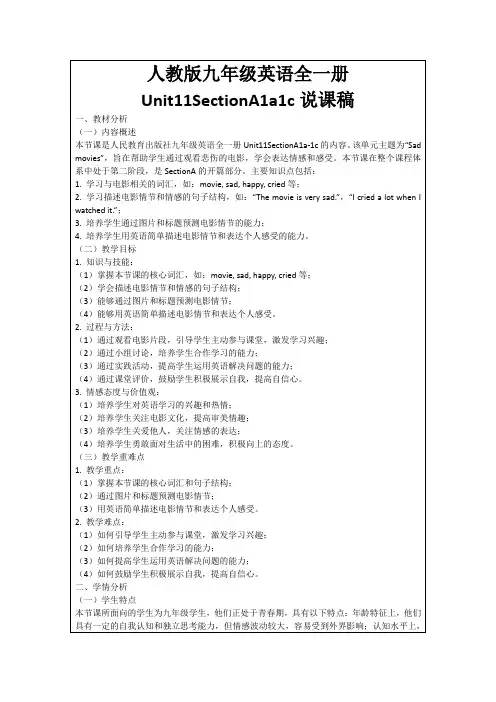
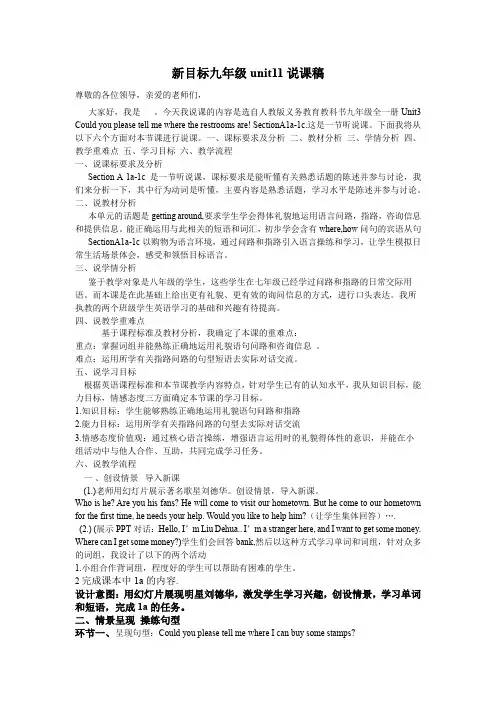
新目标九年级unit11说课稿尊敬的各位领导,亲爱的老师们,大家好,我是。
今天我说课的内容是选自人教版义务教育教科书九年级全一册Unit3 Could you please tell me where the restrooms are! SectionA1a-1c.这是一节听说课。
下面我将从以下六个方面对本节课进行说课。
一、课标要求及分析二、教材分析三、学情分析四、教学重难点五、学习目标六、教学流程一、说课标要求及分析Section A 1a-1c 是一节听说课,课标要求是能听懂有关熟悉话题的陈述并参与讨论,我们来分析一下,其中行为动词是听懂,主要内容是熟悉话题,学习水平是陈述并参与讨论。
二、说教材分析本单元的话题是getting around,要求学生学会得体礼貌地运用语言问路,指路,咨询信息和提供信息。
能正确运用与此相关的短语和词汇,初步学会含有where,how问句的宾语从句SectionA1a-1c以购物为语言环境,通过问路和指路引入语言操练和学习,让学生模拟日常生活场景体会,感受和领悟目标语言。
三、说学情分析鉴于教学对象是八年级的学生,这些学生在七年级已经学过问路和指路的日常交际用语。
而本课是在此基础上给出更有礼貌、更有效的询问信息的方式,进行口头表达。
我所执教的两个班级学生英语学习的基础和兴趣有待提高。
四、说教学重难点基于课程标准及教材分析,我确定了本课的重难点:重点:掌握词组并能熟练正确地运用礼貌语句问路和咨询信息。
难点:运用所学有关指路问路的句型短语去实际对话交流。
五、说学习目标根据英语课程标准和本节课教学内容特点,针对学生已有的认知水平,我从知识目标,能力目标,情感态度三方面确定本节课的学习目标。
1.知识目标:学生能够熟练正确地运用礼貌语句问路和指路2.能力目标:运用所学有关指路问路的句型去实际对话交流3.情感态度价值观:通过核心语言操练,增强语言运用时的礼貌得体性的意识,并能在小组活动中与他人合作、互助,共同完成学习任务。

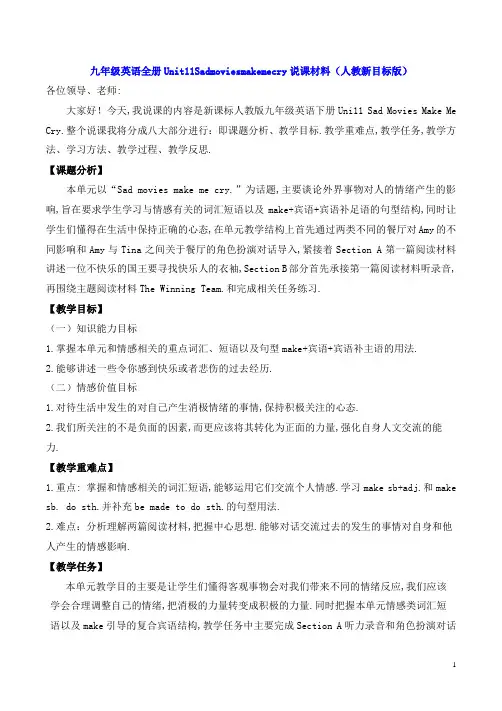
九年级英语全册Unit11Sadmoviesmakemecry说课材料(人教新目标版)各位领导、老师:大家好!今天,我说课的内容是新课标人教版九年级英语下册Uni11 Sad Movies Make Me Cry.整个说课我将分成八大部分进行:即课题分析、教学目标.教学重难点,教学任务,教学方法、学习方法、教学过程、教学反思.【课题分析】本单元以“Sad movies make me cry.”为话题,主要谈论外界事物对人的情绪产生的影响,旨在要求学生学习与情感有关的词汇短语以及make+宾语+宾语补足语的句型结构,同时让学生们懂得在生活中保持正确的心态,在单元教学结构上首先通过两类不同的餐厅对Amy的不同影响和Amy与Tina之间关于餐厅的角色扮演对话导入,紧接着Section A第一篇阅读材料讲述一位不快乐的国王要寻找快乐人的衣袖,Section B部分首先承接第一篇阅读材料听录音,再围绕主题阅读材料The Winning Team.和完成相关任务练习.【教学目标】(一)知识能力目标1.掌握本单元和情感相关的重点词汇、短语以及句型make+宾语+宾语补主语的用法.2.能够讲述一些令你感到快乐或者悲伤的过去经历.(二)情感价值目标1.对待生活中发生的对自己产生消极情绪的事情,保持积极关注的心态.2.我们所关注的不是负面的因素,而更应该将其转化为正面的力量,强化自身人文交流的能力.【教学重难点】1.重点: 掌握和情感相关的词汇短语,能够运用它们交流个人情感.学习make sb+adj.和make sb. do sth.并补充be made to do sth.的句型用法.2.难点:分析理解两篇阅读材料,把握中心思想.能够对话交流过去的发生的事情对自身和他人产生的情感影响.【教学任务】本单元教学目的主要是让学生们懂得客观事物会对我们带来不同的情绪反应,我们应该学会合理调整自己的情绪,把消极的力量转变成积极的力量.同时把握本单元情感类词汇短语以及make引导的复合宾语结构,教学任务中主要完成Section A听力录音和角色扮演对话以及阅读材料的任务,其次涉及单元语法聚焦的训练.Section B部分继续阅读材料一的听录音并展开角色扮演.阅读材料二的阅读任务同时讲故事叙述自己一些令自己悲喜的经历. 【学习方法】本单元的学习过程中,既包括阅读材料中的知识点分析累积以及大声朗读,同时渗透情景互动,多媒体网络资源的搜索,让真实的生活情境融入课堂学习生活中,更加容易强化对单元主题和主要词汇短语以及语法点的了解和记忆.同时以讲童话故事的方式让课堂更加充满趣味性.此外还通过听力训练和课外文章阅读拓展以及话题写作,全面提升学生的听说读写能力.【教学过程】(一)兴趣导入Step 1 通过图片展示Amy在两家截然不同环境的餐馆就餐的情绪反应进行听力训练和角色扮演对话.Step 2 听Section A 2a和2b录音材料,为图片标上序号和完成答题线,同时展开Tina和John 之间的角色扮演对话.(二)新知传授1.阅读理解让学生通读Section A 3a部分阅读文章,提取文章主题思想,积累单元阅读材料中的重点词汇unhappy等,短语be worried about等和make复合宾语句型.认识到塞翁失马焉知非福的道理.2.语法导航主要的语法聚焦make引导的复合宾语结构,通过书本练习加深对句型概念的理解,以及和双宾语结构的区别,巩固英语语言基础.3.角色扮演让学生完成Section A 2d部分角色扮演对话同时结合自身实际,讲述生活中令自己愉快或者悲伤的事情,以及分小组相互讲述课外皇帝的新装或者卖货菜的小女孩等的历史故事,提高学生语言组织能力和实际运用能力.4.竞赛环节分小组讲述生活中令自己悲喜的过去经历,对比谁的故事经历更加吸引同学们的注意力,让课堂气氛更加活跃.(三)要点总结1.将本节课重点词汇短语列出熟记,巩固make的复合结构.2.锻炼学生口语表达讲故事的能力.3.写作练笔:根据本课重点构思小作文—The Experiences That Made Me Happy or Sad. 培养学生写作能力和单元英语语言实际运用能力.4.作业布置:练习册中相应习题和课外辅导书.【教学反思】在教学过程中主要帮助学生掌握单元重点词汇短语和句型等知识,提高英语语言性基础知识,尤其掌握和人的情绪情感相关的词汇短语,同时以情景再现,讲故事等多种方式丰富课堂学习形式.让学生们积极主动参与到教学活动中来.课堂过程中学生们积极性很高,都能主动用英语讲述自己过去的经历,和小组成员互动,在学习巩固自身语言基础的同时,又锻炼了自身语言表达能力.但是有部分同学对自己的英语不自信,课堂上仍有点被动情绪.在以后的教学过程中,应该更加关注这部分同学,从而提高全体同学的英语水平.。
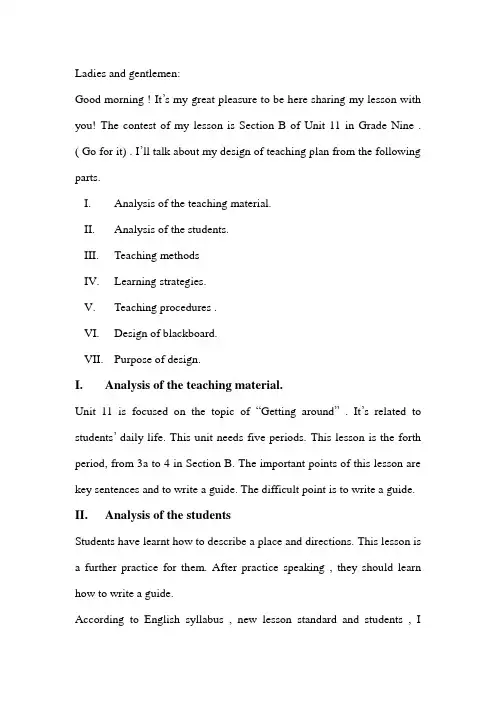
Ladies and gentlemen:Good morning ! It’s my great pleasure to be here sharing my lesson with you! The contest of my lesson is Section B of Unit 11 in Grade Nine . ( Go for it) . I’ll talk about my design of teaching plan from the following parts.I.Analysis of the teaching material.II.Analysis of the students.III.Teaching methodsIV.Learning strategies.V.Teaching procedures .VI.Design of blackboard.VII.Purpose of design.I.Analysis of the teaching material.Unit 11 is focused on the topic of “Getting around” . It’s related to students’ daily life. This unit needs five periods. This lesson is the forth period, from 3a to 4 in Section B. The important points of this lesson are key sentences and to write a guide. The difficult point is to write a guide. II.Analysis of the studentsStudents have learnt how to describe a place and directions. This lesson is a further practice for them. After practice speaking , they should learn how to write a guide.According to English syllabus , new lesson standard and students , Idesign the following learning aims:Teaching aims.1)Language goals. (Memorize and use them)A . Words and expressions:slide / water slide / clown / museum / concertB . Key sentences:a .Watertown is a great place for the family to take a vacation.b . Parents will spend many happy hours walking through the History Museum.2) Ability goalEnable the students to learn how to write a guide3) Emotion and attitude goalEnable the students to know they can learn while playing4) Teaching aidstape reporter, multi-media computer, textbookIII. Teaching methodsI will use a method called “solving problems in five steps.1) Students ask questions after preview.2) Teacher asks questions for students to answer to lead in the new lesson.3) Students try to find out the answers to the questions given by the teacher.4) Students talk in groups to solve what they don’t understand.5) Do exercise to check what they know and what they don’t know.VI. Learning strategiesI’ll encourage students to use the following learning strategies:1) Mind- mapping 2) Cooperative study 3) Use what they learnV. Teaching proceduresNow I’ll mainly talk about this part.Step 1 . Warm-upLet the students listen to the music and do exercise to relax. Ask the students “What do you do to relax on weekend?” Students answer. Then tell the students “ There is a more wonderful place to play , do you want to know?”--- “Now we’ll learn an article about watertown, Unit 11 Section B ” . Show learning aims.Play a game “Match them” .Let students look at explanation of the word, and match the explanation with the word itself.My purpose is that : This game can not only arouse students’ interest but also practice the new words, and help students memorize the words easily. At the same time , it can train students’ abilities of thinking in English. Step 2 Preparing testSince students previewed this lesson, I’ll check what they know and what they don’t know.First , students fill in the chart ,then they tell what they don’t understand, other students help explain. If no one can explain , I’ll explain.Next, students tell important phrases . Ask students to make sentences with the important phrases and memorize the important sentences in two minutes.The purpose of this part is to break through some difficult points and stress important points.Step 3 listen and repeatSome students’ pronunciation is poor. So listen to the tape and repeat to practice pronunciation.The purpose of this part is to train students’abilities of reading and listening.Step 4 GroupworkLet students talk in groups to find out how to write a guide . Some students tell their answers.Learning guide 1Since students know how to write a guide ,they can speak a guide. First , speak by themselves. Then talk in groups to correct mistakes. I’ll offer some pictures.After speaking a guide, ask several students to show their answers. Learning guide 2Let students finish 3b and write a guidePurpose of this part is to improve the students’ abilities of speaking and writing and also their abilities of co-operation , self-learning will be well trained.Step 5 Make a conclusionStudents make a conclusion of what they learn .The purpose is to train students’ ability of making a conclusion.Step 6 Extension (Homework)Work as a guider on weekend or write an e-mail to a foreigner to introduce a place.The purpose is to develop students’ abilities of social practice.VI. Design of blackboardNote1.Bob uncle’s =Bob uncle’s rest aurant2.dress up as ---3.both --- and ---My design of blackboard is clear. It stresses the key points and break through the difficult points, the students can go over the lesson easily. VII.Purpose of designMy purpose of the design is to encourage students to form a habit of thinking by themselves and cooperating with others. At the same time , encourage students to use what they learn to improve their abilities.。
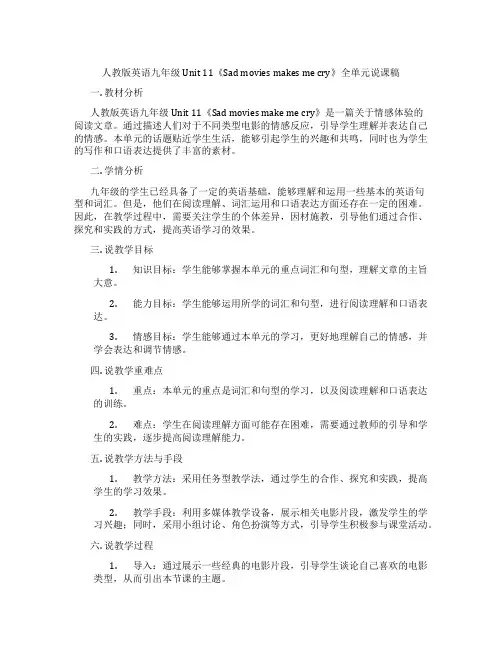
人教版英语九年级Unit 11《Sad movies makes me cry》全单元说课稿一. 教材分析人教版英语九年级Unit 11《Sad movies make me cry》是一篇关于情感体验的阅读文章。
通过描述人们对于不同类型电影的情感反应,引导学生理解并表达自己的情感。
本单元的话题贴近学生生活,能够引起学生的兴趣和共鸣,同时也为学生的写作和口语表达提供了丰富的素材。
二. 学情分析九年级的学生已经具备了一定的英语基础,能够理解和运用一些基本的英语句型和词汇。
但是,他们在阅读理解、词汇运用和口语表达方面还存在一定的困难。
因此,在教学过程中,需要关注学生的个体差异,因材施教,引导他们通过合作、探究和实践的方式,提高英语学习的效果。
三. 说教学目标1.知识目标:学生能够掌握本单元的重点词汇和句型,理解文章的主旨大意。
2.能力目标:学生能够运用所学的词汇和句型,进行阅读理解和口语表达。
3.情感目标:学生能够通过本单元的学习,更好地理解自己的情感,并学会表达和调节情感。
四. 说教学重难点1.重点:本单元的重点是词汇和句型的学习,以及阅读理解和口语表达的训练。
2.难点:学生在阅读理解方面可能存在困难,需要通过教师的引导和学生的实践,逐步提高阅读理解能力。
五. 说教学方法与手段1.教学方法:采用任务型教学法,通过学生的合作、探究和实践,提高学生的学习效果。
2.教学手段:利用多媒体教学设备,展示相关电影片段,激发学生的学习兴趣;同时,采用小组讨论、角色扮演等方式,引导学生积极参与课堂活动。
六. 说教学过程1.导入:通过展示一些经典的电影片段,引导学生谈论自己喜欢的电影类型,从而引出本节课的主题。
2.阅读理解:学生独立阅读文章,完成相关练习题,教师引导学生讨论答案,解答疑惑。
3.词汇学习:学生通过小组合作,归纳和总结文章中的重点词汇和句型,教师进行讲解和拓展。
4.口语表达:学生分组进行角色扮演,模拟文章中的情景,进行口语表达。
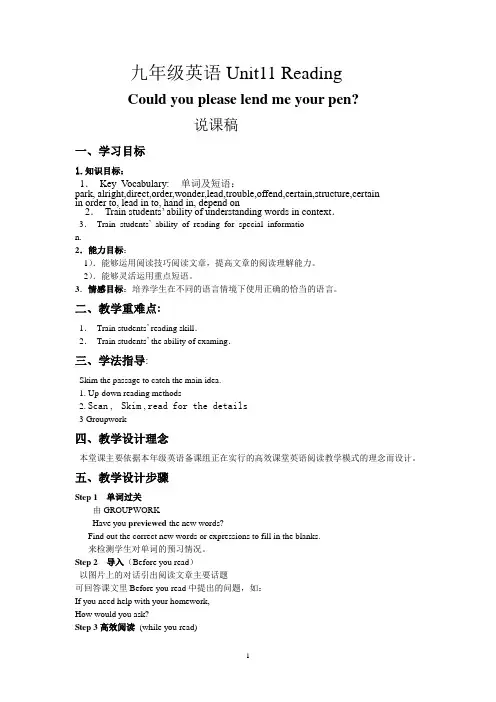
九年级英语Unit11 ReadingCould you please lend me your pen?说课稿一、学习目标1.知识目标:1.Key V ocabulary:单词及短语:park, alright,direct,order,wonder,lead,trouble,offend,certain,structure,certainin order to, lead in to, hand in, depend on2.Train students’ ability of understanding words in context.3.Train students’ability of reading for special information.2.能力目标:1).能够运用阅读技巧阅读文章,提高文章的阅读理解能力。
2).能够灵活运用重点短语。
3.情感目标:培养学生在不同的语言情境下使用正确的恰当的语言。
二、教学重难点:1.Train students’ reading skill.2.Train students’ the ability of examing.三、学法指导:Skim the passage to catch the main idea.1. Up-down reading methods2. Scan , Skim , read for the details3 Groupwork四、教学设计理念本堂课主要依据本年级英语备课组正在实行的高效课堂英语阅读教学模式的理念而设计。
五、教学设计步骤Step 1 单词过关由GROUPWORKHave you previewed the new words?Find out the correct new words or expressions to fill in the blanks.来检测学生对单词的预习情况。
Step 2导入(Before you read)以图片上的对话引出阅读文章主要话题可回答课文里Before you read中提出的问题,如:If you need help with your homework,How would you ask?Step 3高效阅读(while you read)1.Skim(略读)Read the whole passage quickly and silently, and find outWhat is the main idea of this passage?2.Scan (寻读)Read through the passage and find out the main idea of each paragraph .3. Read for details(细读)1).Read the passage carefully and silently, then answer the questions according to passage and tell the reasons .1.What do you think the two questions in paragraph 1?2. Why using correct language is not enough?3. What might the expressions you use depend on?4. What situations you can say “Where is my book? ”5.What does a very direct order sound?6. What should polite questions be?7.What can we do that we don’t offend people?8.Is language etiquette(礼节语言)as important aslearning grammar or vocabulary? Why?2).研究性阅读,解答重难点字,词,句。
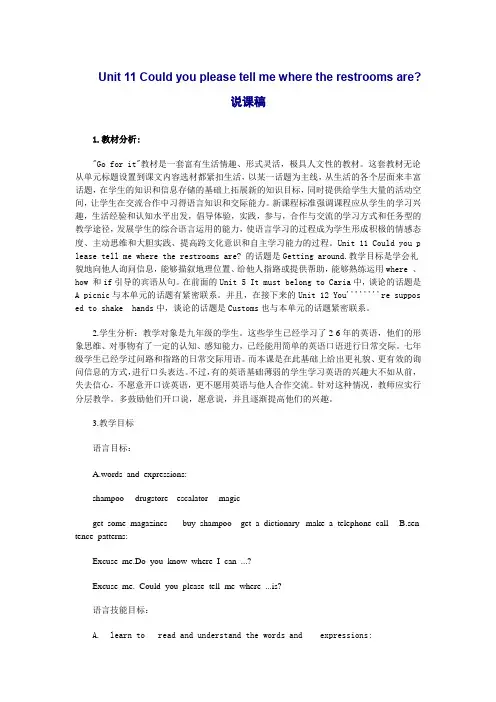
Unit 11 Could you please tell me where the restrooms are?说课稿1.教材分析:"Go for it"教材是一套富有生活情趣、形式灵活,极具人文性的教材。
这套教材无论从单元标题设置到课文内容选材都紧扣生活,以某一话题为主线,从生活的各个层面来丰富话题,在学生的知识和信息存储的基础上拓展新的知识目标,同时提供给学生大量的活动空间,让学生在交流合作中习得语言知识和交际能力。
新课程标准强调课程应从学生的学习兴趣,生活经验和认知水平出发,倡导体验,实践,参与,合作与交流的学习方式和任务型的教学途径,发展学生的综合语言运用的能力,使语言学习的过程成为学生形成积极的情感态度、主动思维和大胆实践、提高跨文化意识和自主学习能力的过程。
Unit 11 Could you p lease tell me where the restrooms are? 的话题是Getting around.教学目标是学会礼貌地向他人询问信息,能够描叙地理位置、给他人指路或提供帮助,能够熟练运用where 、how 和if引导的宾语从句。
在前面的Unit 5 It must belong to Caria中,谈论的话题是A picnic与本单元的话题有紧密联系。
并且,在接下来的Unit 12 You''''''''re suppos ed to shake hands中,谈论的话题是Customs也与本单元的话题紧密联系。
2.学生分析:教学对象是九年级的学生。
这些学生已经学习了2-6年的英语,他们的形象思维、对事物有了一定的认知、感知能力,已经能用简单的英语口语进行日常交际。
七年级学生已经学过问路和指路的日常交际用语。
而本课是在此基础上给出更礼貌、更有效的询问信息的方式,进行口头表达。
不过,有的英语基础薄弱的学生学习英语的兴趣大不如从前,失去信心,不愿意开口读英语,更不愿用英语与他人合作交流。
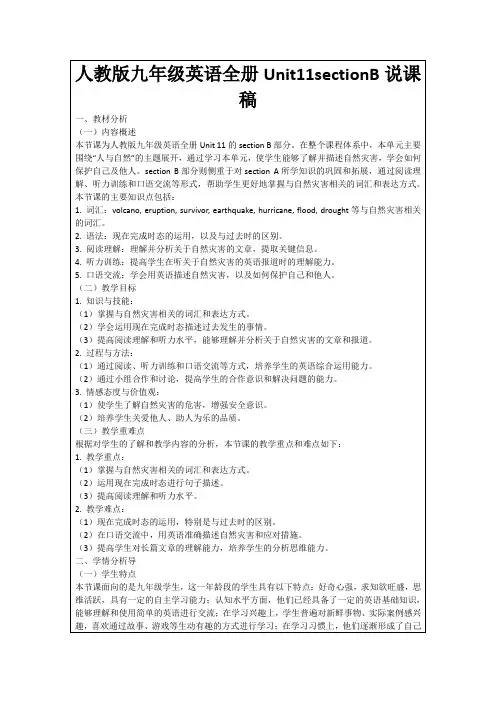
Unit 11 Could you please tell me where the restrooms are?第一课时说课稿一、教材分析:在英语教学中我们应当从整体上把握教材并进行教材分析。
依据任务型教学理念,应先找出本单元中每个课时的中心话题(任务)是什么,然后围绕这个中心话题(任务)展开教学。
本单元围绕“有礼貌地问路并给予相关指点”这个话题展开讨论。
其中第一课时的中心句型是:A:Excuse me. Could you please tell me/ Do you know where I can ------? B: Sure. There is a ------ near here.通过该句型的学习,需掌握一系列的短语和部分地点名词。
教学卡片的利用为任务型教学的实施提供了极大方便。
它增添了学生英语学习们的趣味性,培养了学生用英语思维的能力。
二、教学目标:1、短语学习(中文卡片9张):buy shampoo get some information about the townget some magazines buy some writing papermake a telephone call buy some stampsget a dictionary save money exchange money2、地点名词:(汉语卡片7张):drugstore bookstore Internet barbank department store library post office3、句型训练:A:Excuse me. Could you please tell me/ Do you know where I can ------?B: Sure. There is a ------ near/ around here.4、培养学生的听说演等能力。
三、教学重点:A:Excuse me. Could you please tell me/ Do you know where I can ------?B: Sure. There is a ------ near/ around here.四、教学难点:Could you please tell me/ Do you know where I can ------?从句中的语序:疑问词+ 主语+ 谓语。
新目标人教版英语九年级《Unit 11 Sad movies make me cry》Section A (1a-1c)说课稿我说课的内容是人教新目标九年级英语Unit 11 Sad movies make me cry Section A (1a-1c)整个说课包括教材分析、学情分析、教法学法、教学设计、板书设计、资源开发六大板块。
一、教材分析1.教材的地位及作用:本单元以“how things affect you” 为核心话题,本课是新目标英语九年级第11单元第一课时,教材以餐厅感受为中心话题,练习make+sb.+ adj. make+sb.+ do用法。
Section A 是本单元的重点部分,也是核心部分。
2.教学目标根据《英语课程标准》关于总目标的具体描述,结合本节课的教学内容,我制订了如下目标:1知识与能力..(1) 词汇:能正确使用 would rather(2) 句型:能熟练运用句型The loud music makes Amy nervous.The soft music makes Amy relax.(3) 语法:能运用 make+sb.+ adj. make+sb.+ do.谈论事物对人的影响2过程与方法:通过听力训练与多种形式的口头练习,师生互动、生生互动,使学生能熟练运用新句型进行交际。
3情感与价值观:正确表述自己的感受,理解和体会他人的感受二、学情分析:学生对于谈论事物对人的感受比较感兴趣,且没有生词,学生用起来容易,有成就感。
三教法学法1 听说课的教学模式:语言感知—听说操练—实践运用教师根据本课时目标创设一定的语言情景,师生互动,生生互动,让学生对目标语言有一定的感知后通过大量的听说训练最后能在一定情境中脱口而出,熟练应用。
2 设计理念:听说课的最终目标是灵活运用所学的词汇、句型进行口语交际。
课堂上必须要有充分的时间进行听说口语活动。
教师应该善于把教材中所提供的语言材料转化为声情并茂的语言实践活动,师生需要全情投入,学生需要主动、积极参与,是听说活动的主体。
Unit 11 Sad movies make me cry.Section A (4a4b)说课稿Part 1 Analysis of the Teaching Material(教材分析)Well, firstly, I`ll talk about Part 1, the analysis of teaching material. The main content of this unit is talking about how things affect you, and the topic of this lesson is grammar “make sb. /sth.+adj.” and “make sb. do sth.”.Then I`ll talk about learning objectives. There are knowledge objectives, ability objectives and emotional objectives.1、knowledge objectivesa. To know some new words and phrases of this lesson.b.To know and use the patterns “make sb./sth. +adj.” and “make sb. do sth.”c. To enrich more words about emotions2、ability objectivesa. To improve the Ss’ ability of summarizing and analyzing by observingb. To be able to express one’s emotions and describe one’s reactionsThis is the teaching difficulty in this lesson.3、emotional objectivesa. To help Ss understand the importance of goodfeelingsb. To help Ss learn happilyPart 2 Analysis of the students(学情分析)The students are in Grade Nine now, and they have more interests of learning and speaking English, they are willing to cooperate and municate with others in class, Ithink it’s happy for them to learn the lesson and they will take an active part in the activities in class.Part 3 Teaching methods 教法According to New Course Standard of English(新课标), bining with the language level (语言级别)of Ss, I use 3 methods in my lesson. There are taskbased methods (任务教学法); Cognitive and municative methods(交际教学法); Cooperation and petition methods (合作竞争教学法)。
Unit11Sadmoviesmakemecry说课稿新⽬标九年级英语Unit 11 Sad movies make me cry 说课稿各位评委⽼师,上午好!今天我要说课的题⽬是Unit 11 Sad movies make me cry,以下我将从教材分析、教法、学法和教学过程等⼏个⽅⾯来说⼀说我对本节内容的理解。
那么下⾯先来说说教材⼀、教材分析:本节是九年级英语Unit 11单元第⼀课时1a—2c教学内容。
教学⽬标是通过谈论不同事物对情绪的影响,要求学⽣学习与情感有关的词汇,并在该话题下的听说读写训练中掌握make 作使役动词的语⾔结构。
教学⽬标分析:知识与技能1、能听、说、认读,并理解的新单词和词组单词:drive ,drive sb. crazy/mad ,the more …the more…,lately ,be friendly with ,leave out ,friendship ,would rather ,rather 。
2、能掌握句型:The loud music makes me nervous.Soft and quiet music makes me relaxed.Waiting for Amy drove Tina crazy.Loud music makes John want to leave.情感态度价值观⽬标:了解⼀些表达感情的词,能正确的表达⾃⼰的感情,学会分析不同事物的优缺点,从⽽进⾏优化选择。
学会⽐较选择对⾃⼰有影响的事物,正确处理实际问题,远离不良影响,以积极的姿态,精神饱满地⾯对⽣活与学习。
教学重难点1. 教学重点:能过⽤说学的话题和功能句谈论或询问不同事物对我们的影响能够⽤英语描述⾃⼰的情感。
2. 教学难点:掌握make的⽤法:sth. makes sb.+形容词;sth. makes sb. do 能过在实际情境中围绕“Feelings”(感受)这个话题进⾏交际、谈论或者询问对某件事物的看法,以及谈论事物对⼈的影响。
九年级英语unit11第一课时说课稿本课是新目标英语九年级第11单元,教材以 Could you please tell me the restroom is ? 为中心话题,围绕着描述“一系列地点”展开,学习和使用有礼貌的询问方向展开。
本课教学内容与学生的实际生活密切相关,易于引发学生使用简单的英语实行交际和交流。
本节课为Section A的第一课时,主要学习内容是:复习以前学习的询问方向方式,学习一种更加有礼貌的问路方式“Do you know where I can….?”和“Could you tell me where I can…?”根据课标及11单元的内容,我将本节课(即section A 的第一课时)教学目标细化为以下五方面:语言目标,水平目标,情感和态度目标,策略目标及文化意识目标。
1 .语言目标:1 生词和短语 restroom,.shampoo, drugstore, cafe, department,2 重点句子 Do you know where I can … ? Can you tell me where I can … ? 2 水平目标:能够听懂重要句型及语言结构,并能够仿照例子学会有礼貌的问路。
3 情感和态度目标:当向他人询问时,应注意礼貌用语。
“生活是一面镜子,你给他微笑,他也会他微笑还给你。
”4 策略目标:看图搭配注意语言交际中意思的完整;在学习中与他人合作。
5文化意识目标:在英语语言中,注意礼节,语言的得体。
三说教学重点及难点教学重点:1:复习词汇:library, bank, stamps, post office, department,2:复习句型:Where is the post office ? Is there a post office near here? Yes, It’s on center street.3:学习词汇:shampoo, drugstore, restroom ,cafe, department, escalator;4:学习句型:“Do you know where I can … ? ”“Can you tell me whereI can … ? ”教学难点:疑问句在从句中的准确语序。
Unit 11 Sad movies make me sad.Section A(1a-1c)说课稿各位老师好:今天我说课的内容是人教版新目标英语九年级全一册册第十一单元Unit 11 Sad movies make me cry.的第一课时Section A 1a-1c的教学内容。
我说课的流程依次是:说教材、说学情、说教法、说学法、说教学过程、说板书设计.一.说教材(一)教材的内容,地位和作用本单元围绕“Sad movies make me sad”为中心话题,学习和运用make作为使役动词的make sb +do 和make sb + adj的语言结构.让学生能够描述和谈论不同事物对自己情绪的影响. 要学习的内容与学生们的生活息息相关.其实在初一和初二时对make的结构已经提到过, 本单元是对make 这一结构第一次全面详尽系统的讲授,故学生对本单元没有太大的陌生感.在今天说课的第一课时section (1a-1c)里, 包括三个板块.其中1a 呈现了两幅关于风格迥异的两家餐馆的主题图片,要求学生观察图片,用所学语言知识谈谈餐馆给自己的感觉.活动1b通过听力需要学生听辨出用于描述事物和表达情感的形容词, 用听得形式再次熟悉make这一功能句.1c提供了简短的对话示范,要求学生结合主题图和听力内容完成对本课词汇和功能句的语言输出。
这些教学板块将帮助学生充分熟悉,训练并掌握本课的教学内容.(二)说教学目标教学是为了让学生学到知识,学到能力,培养多方面的情感,让学生在原有的基础上有所提高,有所发展,因此根据新课程标准提出的“三维目标”,为了实现学生的全面发展,注重学生在品德、才智、审美等方面的发展,我把本课的教学目标确定为以下三个方面:1.知识目标:掌握表达情绪和感受的形容词,动词uncomfortable , nervous, sleepy,cry, relax ,掌握 would rather do 宁愿做..... 这一词组.掌握 make sb do和 make sb adj 这一功能句。
..2.能力目标:能够进一步用所学的目标语言进行口头交际及分角色表演对话,提高学生语言表达能力。
通过听力训练提高学生听的能力.3.情感目标:提高学生参与集体活动的积极性和主动性,培养学生的主体参与意识和合作交流能力。
二、教学重难点分析通过对教材和教学大纲的研读,确立了以下重难点.教学重点:掌握重点词汇和make sb do 和make sb adj这一功能句的结构和用法。
教学难点:让学生能正确熟练的运用make sb do 和 make sb adj自己的情绪. 三、说学情授课的学生是九年级的学生, 通过两年的英语学习,他们已经有了一定的英语英语基础和听说能力,基本语法知识已构建完成,对知识已经具备一定的分析,总结,归纳的能力,可以通过引导举一反三.但是对语法知识中细微的区别和细节上的把握.还需要老师的精确点拨.其次,较初一和初二的学生而言,初三学生发言不积极, 课堂气氛也较沉闷, 合作意识不强. 因此我在教学活动中尽量让他们参与到活动中来,有更多的机会来说英语,通过学生间的合作学习,使他们体验到成功的喜悦,以提高他们综合运用语言的能力,使各层次的学生都有所收获四.说教法《英语课程标准》强调课程从学生的学习兴趣、认知水平出发,为学生提供自主学习和相互交流的机会以及充分表现自我的空间,发展学生的综合语言运用能力。
基于上述理论,结合本课的教学内容我安排本课采取以下的教学方法:1.任务型教学法(Task-based teaching method)给学生三项任务,课前布置预习任务, 课中布置小组讨论任务,听力任务,让学生带着这些任务有目的地学习,提供给学生合作交流的空间和时间,,进行探究性学习.2.提供给促使学生为完成任务和同学进行合作,进行探究性学习.2.情景教学法:利用图片创设情景, 设计话题。
What do you think of the two restaueants ?Why do you think so ? Which one would you like to go ? Why ? 使学生身临其境,鼓励学生在用中学,学了就用。
3. 交际教学法Communicative teaching method 学生可以通过俩俩对话和小组讨论来熟练并掌握功能句。
4.听说教学法. Listening and speaking methods5.利用辅助教学的教具图片,录音机. 抽卡五. 说学法《英语课程标准》倡导学生为主体,充分发挥学生的主观能动性。
让学生养成良好的学习习惯,发展自主学习的能力和合作精神。
依据课改的精神,我确定本课的学习策略:1.学会预习:发挥学生的主观能动性,变被动学习为主动学习。
让学生带着问题听课,同时做好听课的词汇“材料”准备。
2.自主学习:教师创设情境,使学生养成独立思考,独立思考,自主完成任务的习惯。
3.学用结合:在充分感知语言现象基础上,联系实际,积极体验,及时反馈,大胆实践。
4. 合作探究法通过小组讨论,充分发挥集体智慧,共同努力攻克学习困难。
六.说教学过程按照新课标提倡的任务型教学途径,本课我安排了课前预习,热身,新课导入、新课讲解,反馈练习,归纳总结,作业六个大环节,以任务为主线贯穿教学始终;我的具体教学流程:课前准备(1)提前制作并下发导学案,制作抽卡(2)布置学生预习内容,完成导学案中的自主学习部分。
■自主学习:根据汉语写出下列英语单词并展示1.感到无聊的__________2. 感到有趣的______________3. 感到轻松的_________4. 伤心的_________5. 昏昏欲睡的______________6.不舒适的_______________7.感到不安的_______________ 8. 难看的_____________9.感到沮丧的____________ 10.感到害怕的_____________11.感到刺激的_____________设计意图:培养学生良好的预习习惯和自主学习能力。
Warming up1.利用抽卡展示描述人情感的形容词。
2.头脑风暴。
How do you relax yourself ?How many kinds of movies do you know ?设计意图:引导学生集中注意,进入学习状态,激发他们深入学习的欲望。
Lead-in1.Do you like action movies ? Why ?Yes. Because they are exciting.Action movies make me excited.They are boring . They make me bored.They are scary. They make me scared.They are funny. They make me sad.They are sad , They make me cry.设计意图:既承接了热身活动中的内容又为新课的教授做了铺垫,有利于知识的延续性和联系性。
新课讲解1. 1a.小组图片讨论展示主题图片,利用图片创设情景。
What do you think of the two restaurant?The first restaurant makes me __________.Why ? Beause of the _________ music and the __________ pictures.The second one makes me _______Why ? Beacuse of the _________ music设计意图:以图画所创设的语言情境进行,直接、形象,易于学生对知识的理解和接受。
又对听力材料进行了预测,对听力材料有一定的指导性。
2. 1b, 听力训练。
第一次播放听力材料,掌握大意。
第二次播放,完成听力填词题。
核对答案。
设计意图:老师对学生的听力进行指导,充分体现了任务型教学,让学生带着任务有目的的进行听力练习,可以提高听力训练的针对性,从而提高学生的听力能力。
3.1c 口语训练教师与一名学生就1c方框中的内容进行示范。
根据图片和听力材料的内容进行两两对话。
展示对话设计意图:通过展示对话,提高学生的口语水平反馈练习【达标测评】1.It rained yesterday, but we still went hiking. And the rainy day______us sad and uncomfortable.A. madeB. makesC. makeD. making2. Jenny likes dancing. Loud music always makes her________.A. want danceB. want dancingC. to danceD. want to dance3. Soft colors usually make people _______.A. relaxingB. relaxedC. excitedD. exciting4. I want to ask her to stay with me ___________.A. rather than leaving meB. rather than leave meC. would rather leave meD. would rather left me5. A: How do you feel about The Blue Lagoon Restaurant?B: _______me relaxed and sleepy.A. They makeB. It makeC. It makesD. It will make设计意图:对本节课所学知识进行测评,把握学生对背包客只是的掌握情况。
总结归纳1.总结本课的重点词汇2.总结本课功能句。
作业布置1. 口头作业:利用早读,记忆所学单词、短语或重点句型。
2. 书面作业:分层次完成导学案中的能力提升题,和挑战题设计意图:尊重学生个体差异,分层布置作业。
说板书设计在板书设计方面主要是将一些重点单词,短语和功能句的结构用法等相关知识写在黑板上。
Unit 11 Sad movies make me sad.Section A(1a-1c)uncomfortable , nervous, sleepy,cry, relax ,would rather do 宁愿做.....make sb do和 make sb adj2.o you like action movies ? Why ?Yes. Because they are exciting.Action movies make me excited.They are boring . They make me bored.They are scary. They make me scared.They are funny. They make me sad.They are sad , They make me cry.课后反思。